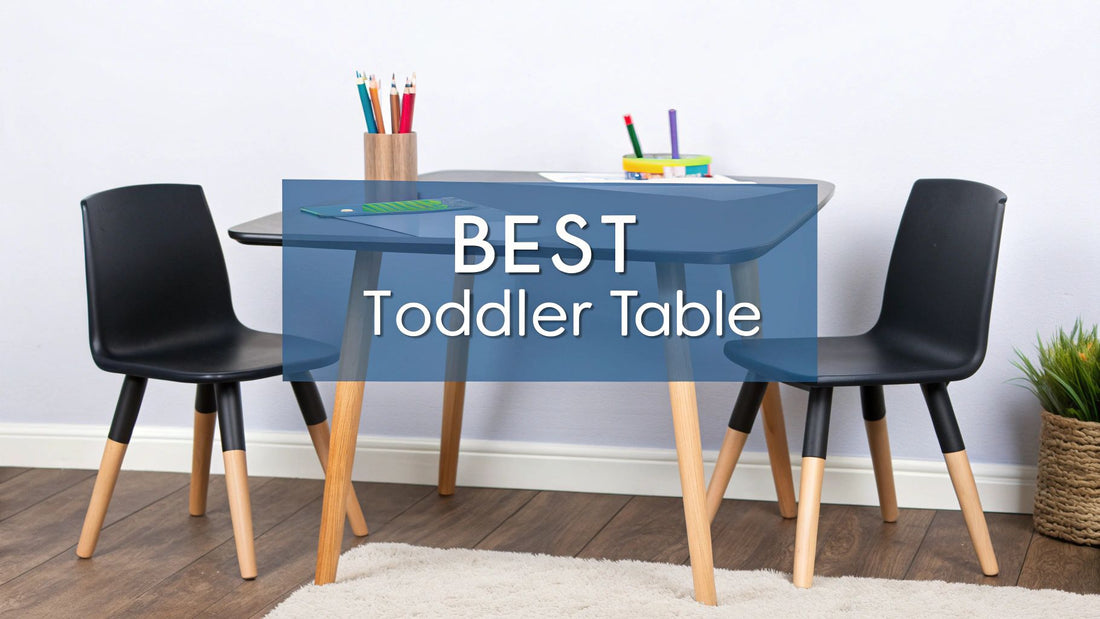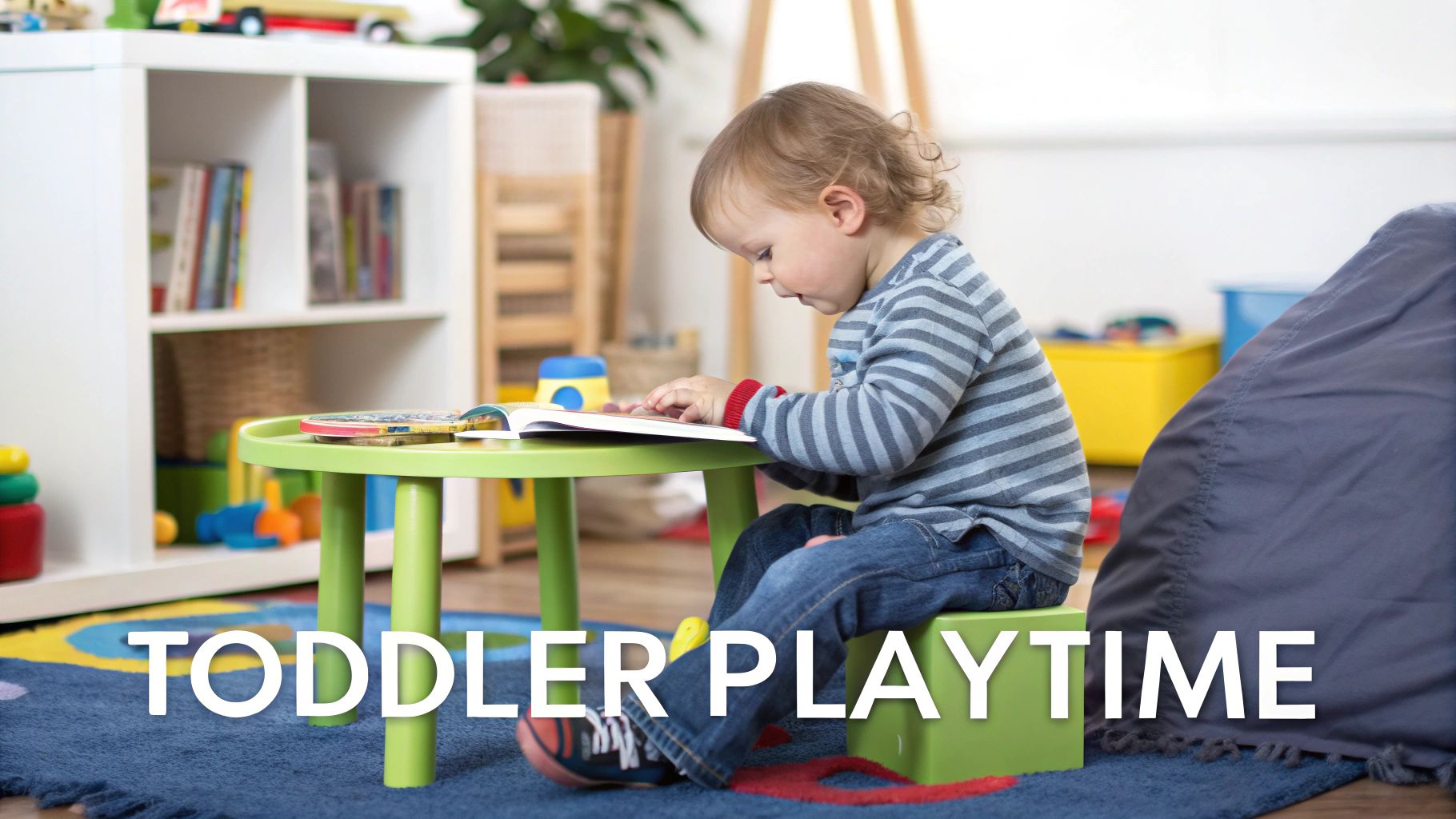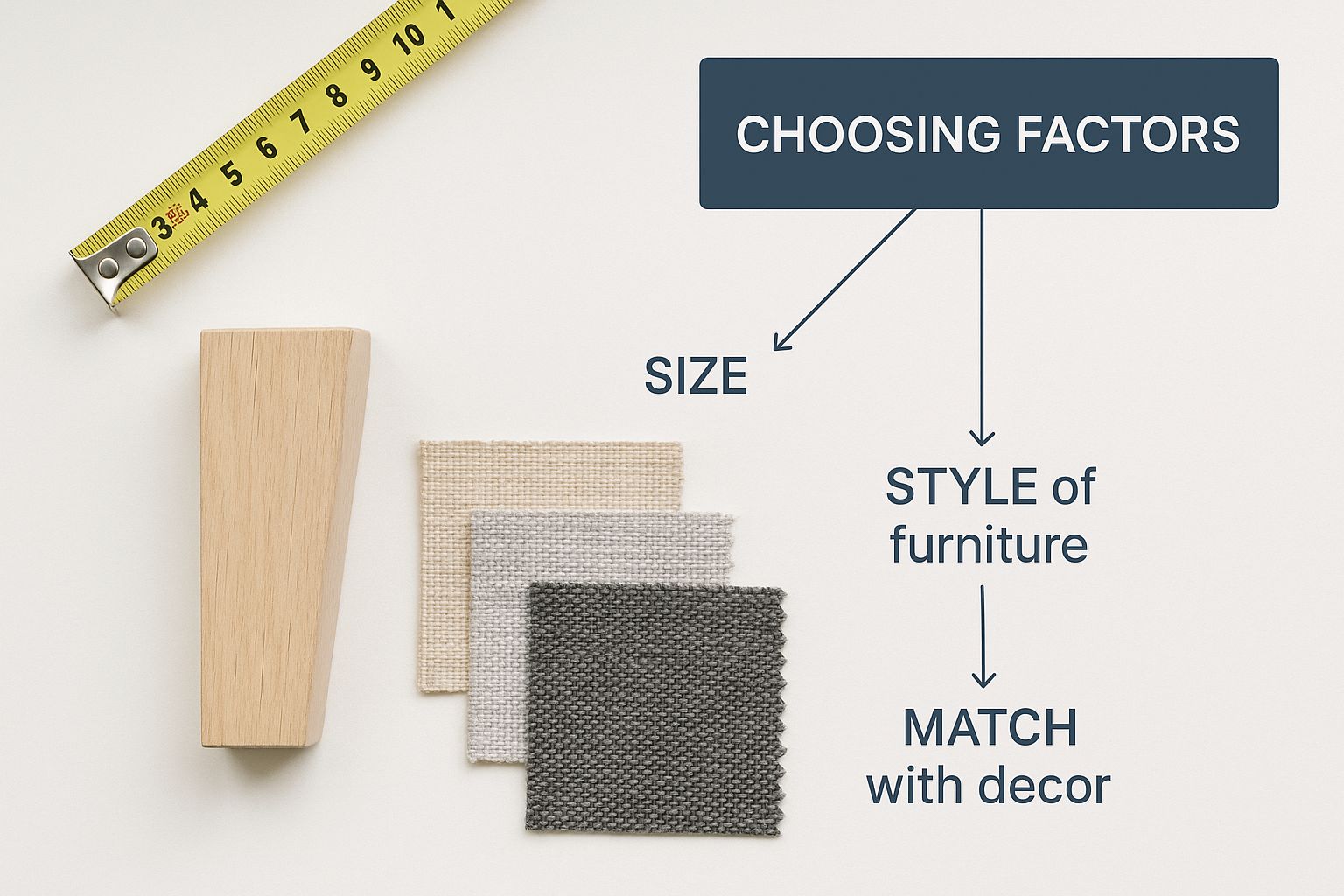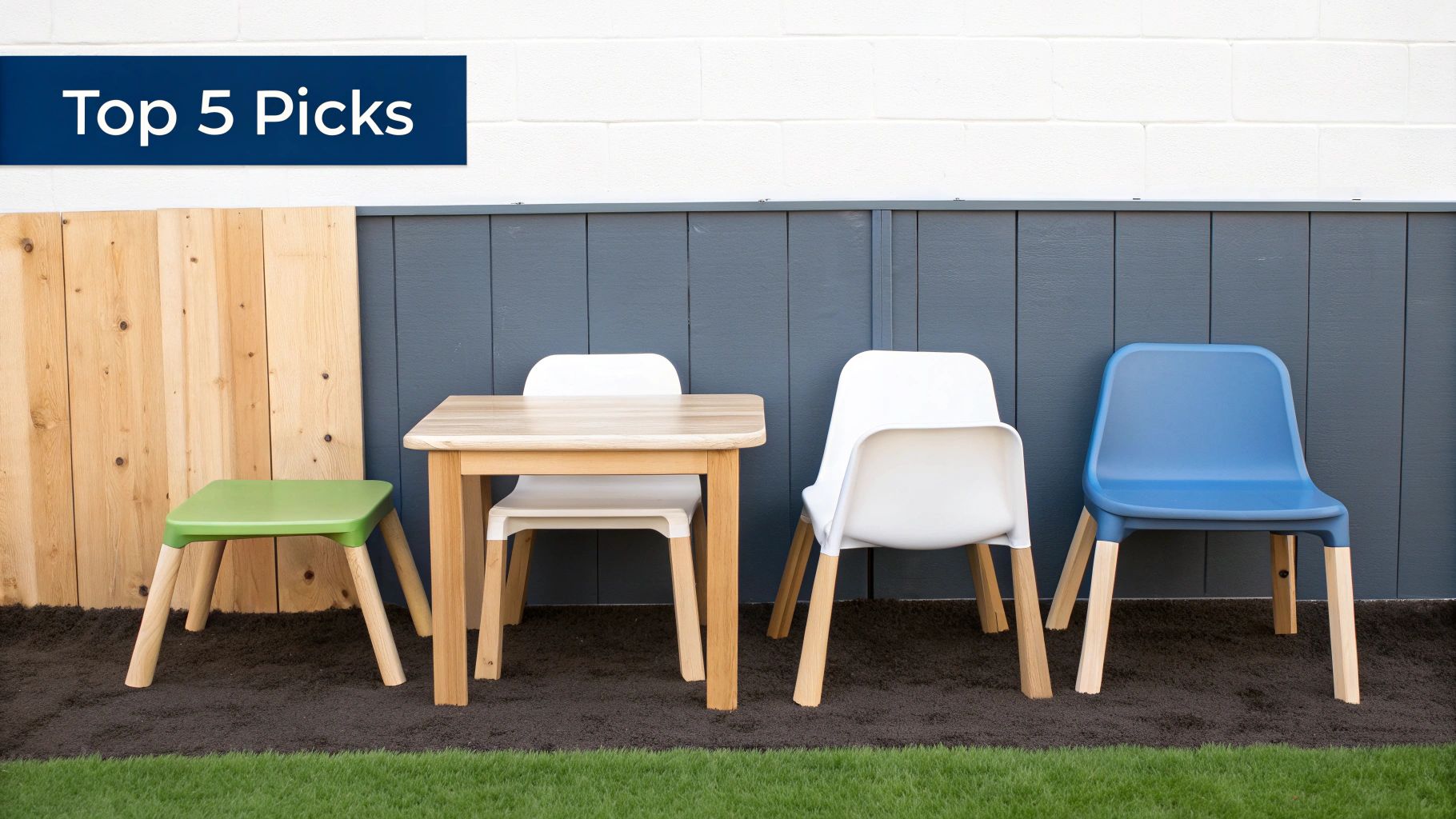
Finding the Best Toddler Table and Chairs
Share
When you're on the hunt for the best toddler table and chairs, you're really looking for a perfect mix of safety, sturdiness, and a design that your little one will love. The best sets almost always have rounded corners, are made from solid wood or easy-to-wipe-clean plastic, and are just the right size to encourage good posture and a bit of independence.
Creating Your Toddler's Creative Corner

Choosing a toddler table isn't just another furniture purchase. It's about carving out a special spot in your home where your child's independence and imagination can really take off. This guide is here to help you look past the product lists and truly understand what makes a set great for your family. Think of it as creating their very first personal workstation—a hub for everything from snack time to their next artistic masterpiece.
Giving them their own dedicated area is a huge confidence booster. It gives them a sense of ownership and a world that’s built to their scale. When kids have furniture that actually fits them, they can sit with their feet flat on the floor, which helps them focus and builds good posture right from the start.
More Than Just a Table
The right set can transform a corner of your home into a dynamic little zone for growth and discovery. It’s the headquarters for their most important work: play. This is where they’ll develop fine motor skills through drawing, practice feeding themselves without the confines of a high chair, and get lost in activities that help stretch their attention span.
This isn't just a small trend, either. The global market for these sets was on track to hit nearly USD 1.5 billion by 2025, which shows just how many parents see the real developmental value in them.
A child-sized table and chair set is one of the first tools you can provide to foster autonomy. It silently communicates, "This space is yours to create, learn, and explore."
Ultimately, the goal is to find a set that supports your child's journey. It needs to be tough enough for daily use while also becoming a beloved part of their routine. With the right choice, this simple piece of furniture becomes the backdrop for countless cherished memories.
A great way to break in their new workspace is with some creative art projects for preschoolers that are fun, easy, and perfect for their new setup.
The Blueprint for a Perfect Toddler Set
Figuring out the features of the best toddler table and chairs is a bit like drawing up a blueprint for your child's first creative headquarters. It’s more than just furniture; it’s about creating a space that’s safe, functional, and genuinely theirs. Before you get swept away by a cute design, let's nail down the non-negotiables that keep your little one safe and comfortable.
The absolute cornerstone of this blueprint is safety. A toddler's world is full of wobbly steps, curious hands, and a whole lot of energy. Their furniture has to be ready for that. Look for smooth, rounded corners to prevent the inevitable bumps and scrapes that come with enthusiastic play.
A stable, tip-resistant design is also a must. Chairs need a wide base so they don't topple over easily, and the table should feel solid, not flimsy. Here's a real-world test: imagine your child leaning their full weight on the edge. Will it hold steady? Any set you consider should pass that test without a wobble.
Non-Toxic Finishes and Certified Materials
Beyond the physical structure, the materials themselves need to be safe. Toddlers explore with their mouths just as much as their hands, which makes non-toxic finishes an absolute must-have. You'll want to look for products that are free from nasty chemicals like lead, phthalates, and formaldehyde.
Certifications are your best friend here. Labels like GREENGUARD Gold or JPMA (Juvenile Products Manufacturers Association) are a shortcut to peace of mind. They signal that a product has passed strict tests for low chemical emissions, which helps keep your indoor air healthier.
This ensures the very air your child breathes while they play is clean and safe, protecting them from hazards you can't even see.
The Foundation of Fun: What's It Made Of?
Next up, let's talk materials. What the set is made from affects everything from how long it lasts to how easy it is to clean up after a messy art session. The two most popular choices are classic solid wood and modern, high-quality plastic.
- Solid Wood: You can't beat the timeless appeal and sturdiness of wood. It offers a natural, sensory experience and its weight adds to the set's stability. The downside? It can be more prone to scratches or water damage if it isn't sealed properly.
- High-Quality Plastic: This is the practical choice for many busy families. It's praised for being lightweight, a breeze to clean, and usually easier on the wallet. Modern plastics can handle spills and crayon masterpieces with a simple wipe-down.
There’s no right or wrong answer; it’s all about what fits your lifestyle. Are you looking for an heirloom piece that will last for years, or do you need the easy-maintenance convenience of plastic?
Getting the Fit Just Right: Toddler Ergonomics
Finally, let's break down 'toddler ergonomics'. Simply put, it's about making sure the set is a comfortable fit that supports their growing body. A poorly sized table set is like giving your toddler shoes that are three sizes too big—frustrating, awkward, and not very helpful.
The goal is to find a set where your child can sit with their feet flat on the floor and their knees bent at a nice, comfortable 90-degree angle. When they're sitting, the tabletop should be right around elbow height. This allows them to draw, eat, or play without having to hunch over or strain their little necks and shoulders.
Getting this alignment right does more than just encourage good posture. It helps them focus on their activities for longer, turning their little corner into a space where they can truly thrive.
Choosing The Right Material For Your Family
The material you choose for your toddler's table set is more than just a style decision. It’s the foundation for how durable it is, how safe it is, and—let's be honest—how much time you'll spend scrubbing it. It's a bit like picking out shoes; what you need for a rainy day puddle-jumping session is totally different from what you'd wear to a party. The best material is all about what fits your family's daily life.
You'll mostly run into three main options: classic solid wood, practical engineered wood, and the ever-versatile plastic. Each one has its own personality, catering to different needs, whether you're setting up a messy art station or a quiet corner for looking at picture books.
This image breaks down the key things to think about when you're weighing your options.

As you can see, the perfect choice really comes down to a balance between your budget, how much cleaning you're willing to do, and what the furniture will be used for day in and day out.
The Warmth and Durability of Wood
There's a reason solid wood has been the go-to for furniture forever. It’s incredibly sturdy, has a timeless look, and offers a natural, warm feel for your child. A well-made wooden set can almost feel like a future heirloom, tough enough to handle years of play and maybe even get passed down.
On the flip side, solid wood usually costs a bit more and is heavier, so you won't be moving it around the house as easily. And while it’s tough, it can get scratches or water rings if you don't wipe up spills right away. Think of it as an investment in a piece that will last and look beautiful for years.
Engineered Wood: A Smart Alternative
Engineered woods, like Medium-Density Fiberboard (MDF), give you the look of wood but at a much more wallet-friendly price. This material is made by pressing wood fibers together with resin, creating a super smooth surface that's perfect for painting in bright, fun colors.
The trade-off here is usually in the durability department. MDF isn't quite as tough as solid wood and can be susceptible to moisture damage if the paint or finish gets chipped. It’s a fantastic middle-ground option if you love the wooden aesthetic but not the premium price tag.
The Practical Power of Plastic
High-quality plastic sets are the unsung heroes of easy-peasy cleanup. They are lightweight, super affordable, and ridiculously simple to wipe down. Crayon marks, dried paint, and spilled juice? No problem. This makes plastic a brilliant choice for a dedicated art or snack table.
Modern plastic furniture is often designed with safety as a top priority, featuring rounded edges and a stable build. It’s the ultimate grab-and-go set—you can easily move it from the playroom to the backyard for some fun in the sun.
While it might not have that classic, cozy look of wood, its sheer practicality is tough to beat.
To make things even clearer, here’s a quick rundown of how these materials stack up against each other.
Toddler Table Material Comparison
This table gives you an at-a-glance look at the pros and cons of each material, helping you pinpoint which one is the best fit for your home and lifestyle.
| Material | Pros | Cons | Best For |
|---|---|---|---|
| Solid Wood | Extremely durable, stable, timeless aesthetic, can be refinished | Higher cost, heavier, can be scratched or stained | Families wanting a long-lasting, heirloom-quality piece that blends with home decor. |
| Engineered Wood | Budget-friendly, smooth surface for painting, lighter than solid wood | Less durable, susceptible to water damage if finish is compromised | Those seeking the look of wood on a budget, for gentle to moderate use. |
| Plastic | Very affordable, lightweight, easiest to clean, weather-resistant | Can be less aesthetically pleasing, may be less stable than wood | Messy activities like arts and crafts, outdoor use, and busy families prioritizing convenience. |
Ultimately, whether you go for the enduring charm of wood or the unbeatable convenience of plastic, the right material is the one that makes your life easier and your toddler’s space more functional and fun.
Why Size and Fit Matter for Little Ones

Picking the right size for a toddler table set goes way beyond just making sure it fits in your playroom. It’s really about creating a little world where your child feels comfortable, capable, and totally in control.
Just imagine trying to work at a desk where your feet are dangling a foot off the ground and the tabletop is practically at your chin. That’s exactly what an oversized, ill-fitting table feels like to a toddler. It's awkward and frustrating.
When a chair and table are the right size, it unlocks a whole new level of independence. A good fit supports healthy posture and gives them the physical stability they need to really focus on drawing, snacking, or building with blocks. It's a small detail that can make a huge difference in how long they’ll happily sit and play.
Finding the Perfect Fit for Your Toddler
So, how do you find that "just right" Goldilocks fit? The goal is to achieve what experts call toddler ergonomics. It sounds fancy, but it’s actually pretty simple and sets them up for good habits down the road.
Here’s what to look for:
- Feet Flat on the Floor: When your child is sitting down, their feet should rest comfortably flat on the ground. This gives them a sense of stability and security.
- Knees at a 90-Degree Angle: Their knees should bend at a nice, easy right angle. This is the sweet spot for ergonomic support and comfort.
- Elbow-Height Tabletop: The table surface should be right around their elbow height when they're sitting up straight. This stops them from hunching over or having to reach up awkwardly.
Nailing these three things turns the table into a truly welcoming space for your child to create, learn, and just be a kid.
Investing in Furniture That Grows with Them
We all know how fast toddlers grow. One minute their pants fit, the next they’re halfway up their shins. That’s why an adjustable set is such a brilliant long-term investment.
These clever designs often have reversible chairs with different seat heights or table legs that can be extended. What seems like a minor feature now becomes a lifesaver over the next few years, easily adapting to growth spurts and making the furniture last so much longer.
By choosing furniture that fits properly, you are not just buying a table; you are investing in your child's posture, focus, and burgeoning sense of independence.
This shift toward well-designed, child-centric furniture is a huge trend. The kids' furniture market is actually expected to grow to USD 55.1 billion by 2035, all driven by a worldwide focus on creating home environments that are both safe and supportive for development.
This same principle of ergonomic support applies to more than just tables. Making sure your child can safely reach the sink to wash their hands or help at the counter also builds that all-important independence. It's why finding the best step stool for kids is another key piece in creating a truly child-friendly home.
Designs That Do More Than Just Sit There
These days, toddler tables are so much more than just a surface for scribbling. The best sets are packed with clever, multifunctional features that turn them into a true hub for learning and play, completely changing how your child uses their little corner of the world.
Think of these designs as the Swiss Army knife of kid's furniture. They’re built to solve common problems—like clutter and tight spaces—while sparking a whole new range of creative activities for your little one.
Smart Storage Solutions
One of the most practical upgrades is built-in storage. Many modern sets have hidden compartments right under the tabletop, perfect for stashing away crayons, paper, and small toys. Others feature a central mesh bag or removable fabric bins that hang between the legs, keeping supplies handy but off the floor.
This isn't just about being tidy; it's about fostering independence. When kids can easily grab and put away their own stuff, it empowers them and teaches great organizational habits from a young age. This idea lines up perfectly with educational philosophies that focus on self-sufficiency, which we dive into in our guide to the Montessori table and chair.
Tabletops That Transform
Another brilliant feature is the reversible tabletop. One minute, it’s a smooth, flat surface for snacks or drawing. The next, you flip it over to reveal a building block base, instantly creating a construction zone.
A multifunctional table doesn't just save space—it expands the possibilities for play. It’s an invitation for your child to explore different activities without needing separate pieces of furniture for each one.
This kind of adaptability is a huge reason why the kids' furniture market has exploded, growing from USD 65.95 billion in 2024 to an estimated USD 78.96 billion in 2025. This jump is all thanks to parents wanting smart, educational, and space-saving designs that support their child's development. You can get the full scoop on these trends from the kids furniture market report on ResearchAndMarkets.com.
Creative and Sensory Features
Beyond storage and flippable tops, many designs cater to specific kinds of play:
- Integrated Paper Rolls: A built-in paper roll is a dream for little artists. It offers an endless canvas for drawing and painting without the mess of loose sheets flying everywhere.
- Sensory Bins: Some tables come with removable plastic bins. You can fill them with sand, water, or other sensory materials, giving your child a contained space for some hands-on, tactile exploration.
These thoughtful additions turn a simple piece of furniture into a dynamic activity center, making sure it stays a well-loved part of your home for years to come.
Bringing It All Home
You've done the hard work, sifted through all the options, and the perfect little set is finally making its way to you. Now for the really fun part: watching that new table and chairs become a central hub for your child's world.
To make sure this transition is a happy one, let's do a quick final check on the things that really matter. Did you cover all your bases?
- Safety First: Are those corners rounded and the finishes confirmed to be non-toxic?
- Material Match: Did you pick a material—wood, plastic, or something else—that can handle your family's daily chaos?
- The Perfect Fit: When your toddler sits down, can their feet rest flat on the floor?
- Smart Features: Does it have that handy built-in storage or another feature you were hoping for?
Creating an Inviting Little Corner
Once the set arrives, think carefully about where it will live. You want it to be an accessible, welcoming spot that practically begs for an art project to be started.
A corner of the living room or kitchen is often a fantastic choice. Why? Because toddlers are social creatures who love being right in the middle of the family action. This lets them work on their masterpieces while still feeling connected to whatever you’re doing.
If you have a dedicated playroom, find a nice, well-lit spot. Set it up with their favorite art supplies or toys on a nearby shelf, making it super easy for them to dive in all by themselves.
The goal is to make their new furniture feel like an invitation, not a command. It’s their own personal headquarters for all things creative.
Making It Theirs
The best way to get your toddler excited about their new furniture is to involve them right from the start. Let them "help" you wipe it down with a cloth or arrange their favorite crayons in a cup on the table.
Frame it as their special, big-kid spot.
Try saying something like, "This is your very own table for drawing amazing pictures!" or "Let's have our snack at your new table today." By linking it to fun, positive experiences from day one, you help build a sense of ownership. Before you know it, it'll be a well-loved fixture, ready for years of happy memories.
A Few Final Questions We Hear from Parents
Even after you think you’ve found the one, a few last-minute questions always seem to pop up. It’s a big purchase, and you want to get it right. We get it.
We’ve pulled together the most common questions we hear from parents to give you clear, simple answers. Let's get these last few details sorted out so you can feel 100% confident in your choice.
When Is the Right Time for a Toddler Table?
The sweet spot for bringing a toddler table and chair set into your home is usually between 18 months and 2 years old. But honestly, it's less about their age and more about their readiness.
Look for the signs. Can your child sit up confidently on their own? Can they get in and out of a small chair without too much of a struggle? If so, they’re ready. Introducing a set now gives them a huge boost of independence and a space that’s perfectly sized just for them.
Giving a child their own furniture is like saying, "This space is yours." It helps them build self-confidence, a sense of responsibility, and a love for their own little creative corner.
How Do I Clean Up Those Tough Messes?
Life with a toddler is messy—and their furniture will see it all. From crayon masterpieces to marker mishaps, the best way to clean up depends on the material.
- Plastic Sets: A magic eraser usually does the trick. If not, a simple cloth with a bit of mild soap will wipe away just about anything.
- Finished Wood Sets: Start with a soft, damp cloth. For really stubborn stains, a paste made from baking soda and water can often lift them right off. Just be sure to test any new cleaning solution on a small, hidden spot first to make sure it doesn't mess with the finish.
A little pro-tip: make it a habit to regularly check that all the screws and bolts are tight. It’s a small but crucial part of maintenance that keeps the set safe and sturdy through all their daily adventures.
Are Built-In Storage Features Really Worth It?
This is a big one for parents trying to juggle space and budget. The short answer? Yes, integrated storage can be a game-changer, especially if you’re tight on space.
Features like a central mesh bag or little bins under the table keep art supplies and tiny toys contained and right where your child can reach them. It’s a fantastic way to cut down on clutter and gently teach your toddler how to tidy up after playtime.
But, if you've already got a great toy storage system going, a simpler table without all the bells and whistles might be all you need to complete their little creative nook.
At Ocodile, we design furniture that grows with your child, blending safety, style, and practicality. Discover our collection of child-friendly furniture and create a space where your little one can thrive. Explore our products at https://ocodile.com.








